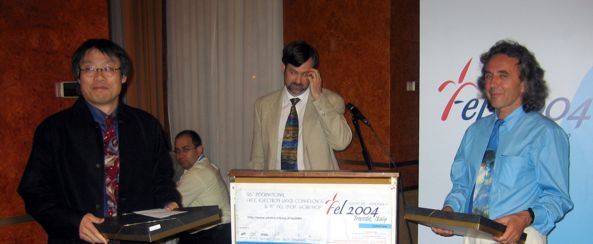FEL Prize

Steve Benson awards the 2004 FEL prize to Hiroyuki Hama and Vladimir Litvinenko.
Vladimir Litvinenko and Hiroyuki Hama have performed fundamental
and pioneering contributions in Storage Ring Free Electron Lasers
(SRFELs). Thanks to their deep understanding of the FEL and to their
achievements, they have promoted the use of SRFELs in a broad
scientific community, from synchrotron radiation to nuclear physics.
They have both worked innovatively at the frontiers of
SRFELs. V. Litvinenko installed the electromagnetic optical klystron
OK4 on the by-pass of VEPP3 at Akadiemgorodok (Russia) in 1988, and
H. Hama installed the first optical klystron with adjustable
planar-to-helical field in 1996 on UVSOR in Okazaki (Japan). These
improvements produced new short wavelength records for FELs:
240 nm for VEPP3 SRFEL in 1988, 238 nm for the UVSOR SRFEL
in 1996. Then, after a move by Litvinenko to Duke University,
226 nm in 1998, and to 193 nm in 1999.
They have both been very active in advancing the understanding of
storage ring FEL dynamics, H. Hama performed very early systematic
sophisticated experimental analysis of the FEL micro-pulse temporal
and spectral distribution versus time for different operating
conditions starting in 1994. He also carried out detailed studies on
FEL performances for different momentum compaction
factors. V. Litvinenko developed a complete theoretical model of giant
and super pulses whose findings are in good agreement with
measurements performed on the DUKE FEL, and used super pulses to
produce strong coherent harmonics.
They have developed technological improvements to SRFELs that
improve the device for users. Hama developed a feedback system to
maintain the FEL pulse at perfect synchronism, leading successful
pump-probe two-color experiments in gas phase using FEL light and
synchrotron radiation for the first time. A transverse feedback
system was developed in Duke FEL to stabilize beam operation.
A very important contribution of their work has been the production
of monochromatic gamma-rays by Compton Back-Scattering with
SRFELs. Hama performed the first experimental demonstration at UVSOR
in 1996 in the MeV range. At Duke University, Litvinenko developed a
high intensity gamma ray user facility (HIGS), leading to new
discoveries in Nuclear Resonant Fluorescence and near-threshold
break-up of Deuterium. This has broadened the use of FELs into the
field of nuclear physics.
Besides their leading role in FELs, they continue to make important
contributions to the field of physics as a whole. They have trained
many graduate students and have assisted in the commissioning of
numerous synchrotron light sources. Both operated FEL user facilities
providing hundreds of hours of FEL light to users each
year. Litvinenko is now working on electron-ion colliders. Hama is
involved in the design of the next generation of storage rings in
Japan.
The FEL Prize Committee
An overview of FEL Prize Winners
- 2004 (Trieste) Vladimir Litvinenko and Hiroyuki Hama
- 2003 (Tsukuba) Li-Hua Yu
- 2002 (Argonne) H. Alan Schwettman and Alexander F.G. van der Meer
- 2001 (Darmstadt) Michel Billardon, Marie-Emmanuelle Couprie, and Jean-Michel Ortega
- 2000 (Durham) Stephen V. Benson, Eisuke J. Minehara, and George R. Neil
- 1999 (Hamburg) Claudio Pellegrini
- 1998 (Williamsburg) John Walsh
- 1997 (Beijing) Kwang-Je Kim
- 1996 (Rome) Charles Brau
- 1995 (New York) Richard Pantell and George Bekefi
- 1994 (Stanford) Alberto Renieri and Giuseppe Dattoli
- 1993 (The Hague) Roger Warren
- 1992 (Kobe) Robert Phillips
- 1991 (Santa Fe) Phillip Sprangle and Nikolai Vinokurov
- 1990 (Paris) Todd Smith and Luis Elias
- 1989 (Naples, FL) William Colson
- 1988 (Jerusalem) John Madey
| 
